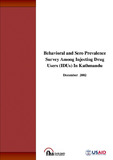Please use this identifier to cite or link to this item:
https://hdl.handle.net/20.500.14356/688| Title: | Behavioral and Sero Prevalence Survey Among Injecting Drug Users (IDUs) In Kathmandu December 2002 |
| Authors: | Family Health International NEW ERA SACTS |
| Issue Date: | 2002 |
| Keywords: | Behavioral and Sero Prevalence Survey Injecting Drug Users (IDUs) Kathmandu Valley |
| Abstract: | EXECUTIVE SUMMARY HIV transmission among drug users is typically associated with injecting drug users who often times share needles or syringes. Risky behavior has been defined here as needle sharing behaviors, unprotected sex with various partners or sex workers. Risky sexual behavior associated with the drug use also contributes to spread HIV. Injecting drug users function as a “bridging population” for HIV transmission between a core HIV risk group and general population. The main objective of this study is “to estimate the prevalent rates of HIV among IDUs and assess their role in the transmission of HIV.” The study was conducted in four municipalities of Kathmandu, Lalitpur and Bhaktapur districts. Three-hundred and three male IDUs were sampled from 20 different randomly selected sites, through respondent driven sampling (RDS). In Kathmandu, fifty-seven females were sampled randomly instead of using the RDS method. While structured questionnaires were used to collect behavioral data, clinical blood tests helped determine HIV infection rates. The clinical test procedure used involved collecting blood from a subject’s pricked finger and then storing said blood in 2-4 capillary tubes until tests could be performed. In order to determine a participants’ infection status, researchers conducted two rapid ‘Capillus’ and ‘Determine’ tests. The nature of these tests is explained in section 2.2. In terms of socio-demographic characteristics of IDUs within the Kathmandu valley, we found a portion of the population that had several factors against it. The study found that the median age of male and female IDUs was 25 and 23 years respectively. Majorities of the IDUs were either previously or currently married. The median age for marriage in males is 22 and 15.5 in females. Additionally, it was found that female IDUs demonstrated a higher illiteracy rate than males (42% Vs 3%). IDUs from a variety of different ethnic groups participated in the study. |
| URI: | http://103.69.126.140:8080/handle/20.500.14356/688 |
| Appears in Collections: | Post Graduate Grant (PG) Reports |
Files in This Item:
| File | Description | Size | Format | |
|---|---|---|---|---|
| IDU-KTM_2002 Final .pdf | Full Report. Download | 322.01 kB | Adobe PDF |  View/Open |
Items in DSpace are protected by copyright, with all rights reserved, unless otherwise indicated.
